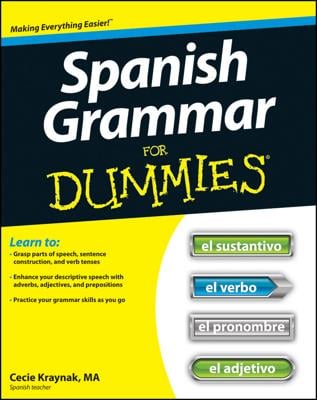The pluperfect and the preterit perfect convey past actions that are more past than others. For example, in the sentence, “After I had heard that grasshoppers were a delicacy in Mexico, I decided to try them,” had heard is the past perfect verb because it happened before the speaker decided to try the crunchy critters.
Even though the two tenses have different conjugations of haber in Spanish, they’re translated exactly the same into English. The difference between the tenses is when you use them. Pluperfect is commonly used in conversation. Preterit perfect is commonly used in formal writing and literature.
In most cases, you’re going to use the pluperfect. You can pretty much ignore the preterit perfect, unless you’re reading or writing a novel in Spanish or presenting a formal paper.
Forming the pluperfect tense
To form the pluperfect tense, you start with the imperfect conjugation of the verb haber and then tack on the past participle of the main verb. Fortunately, haber follows the rules of regular -er verbs in the imperfect tense — dropping the infinitive verb ending and then add the endings -ía, -ías, -ía, -íamos, -íais, and -ían. Following is the conjugation chart you need to etch on your brain cells.| Conjugation | Translation |
|---|---|
| yo había | I had |
| tú habías | You (informal) had |
| él/ella/ello/uno había | He/she/one had |
| usted había | You (formal) had |
| nosotros habíamos | We had |
| vosotros habíais | You all (informal) had |
| ellos/ellas habían | They had |
| ustedes habían | You all (formal) had |
Coming up with the right conjugation of haber is just the first step in forming your compound verb conjugation. You must then add the past participle of the verb whose action is being described.
Here are some example sentences using the pluperfect:-
Nosotros habíamos limpiado la casa antes de salir. (We had cleaned the house before we left.)
-
Ellos habían comido antes de que nosotros llegamos. (They had eaten before we arrived.)
Touching on the preterit perfect
Of the seven compound tenses, the preterit perfect is the one you’re likely to use least often. It’s a strictly formal tense that may come in handy for your reading or composition but won’t come up in conversation.To form the preterit perfect, you begin with the preterit tense of the verb haber and then add the past participle of the main verb. It just so happens that the preterit conjugations of haber are irregular, so you need to memorize the following conjugation chart.
| Conjugation | Translation |
|---|---|
| yo hube | I had |
| tú hubiste | You (informal) had |
| él/ella/ello/uno hubo | He/she/one had |
| usted hubo | You (formal) had |
| nosotros hubimos | We had |
| vosotros hubisteis | You all (informal) had |
| ellos/ellas hubieron | They had |
| ustedes hubieron | You all (formal) had |
Don’t forget to add the past participle of the main verb. It must appear immediately after the verb haber.
Here are some example sentences using the preterit perfect:-
Juan hubo ido al parque. (Juan had gone to the park.)
-
Yo hube visto los niños. (I had seen the children.)

